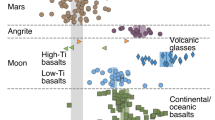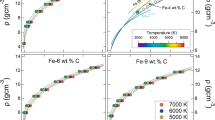Abstract
The solid inner core of the Earth and the liquid outer core consist mainly of iron1 so that knowledge of the high-pressure thermodynamic properties of iron is important for understanding the Earth's deep interior. An accurate knowledge of the melting properties of iron is particularly important, as the temperature distribution in the core is relatively uncertain2,3,4 and a reliable estimate of the melting temperature of iron at the pressure of the inner-core boundary would put a much-needed constraint on core temperatures. Here we used ab initio methods to compute the free energies of both solid and liquid iron, and we argue that the resulting theoretical melting curve competes in accuracy with those obtained from high-pressure experiments. Our results give a melting temperature of iron of ∼6,700 ± 600 K at the pressure of the inner-core boundary, consistent with some of the experimental measurements. Our entirely ab initio methods should also be applicable to many other materials and problems.
This is a preview of subscription content, access via your institution
Access options
Subscribe to this journal
Receive 51 print issues and online access
$199.00 per year
only $3.90 per issue
Buy this article
- Purchase on Springer Link
- Instant access to full article PDF
Prices may be subject to local taxes which are calculated during checkout

Similar content being viewed by others
References
Poirier,J. P. Introduction to the Physics of the Earth's Interior (Cambridge Univ. Press, 1991).
Anderson,O. L. & Duba,A. Experimental melting curve of iron revisited. J. Geophys. Res. 102, 22659– 22669 (1997).
Shen,G., Mao,H., Hemley,R. J., Duffy,T. S. & Rivers, M. L. Melting and crystal structure of iron at high pressures and temperatures. Geophys. Res. Lett. 25, 373–376 (1998).
Belonoshko,A. B. & Ahuja,R. Embedded-atom molecular dynamics study of iron melting. Phys. Earth Planet. Inter. 102, 171–184 (1997).
Gillan,M. J. The virtual matter laboratory. Contemp. Phys. 38, 115–134 (1997).
Car,R. & Parrinello,M. Unified approach for molecular dynamics and density functional theory. Phys. Rev. Lett. 55, 2471–2474 (1985).
Perdew,J. P., Chevary,J. A., Vosko,S. H., Jackson,K. A., Pederson,M. R., Singh,D. J. & Fiolhais,C. Atoms, molecules, solids and surfaces: Applications of the generalized gradient approximation for exchange and correlation. Phys. Rev. B 46, 6671–6687 (1992).
Stixrude,L., Cohen,R. E. & Singh,D. J. Iron at high pressure: Linearized-augmented-plane-wave computations in the generalized-gradient approximation. Phys. Rev. B 50, 6442–6445 ( 1994).
Vočadlo,L., Brodholt,J., Alf,D., Gillan,M. J. & Price,G. D. Ab initio free energy calculations on the polymorphs of iron at core conditions. Phys. Earth Planet. Inter. (in the press).
Sšderlind,P., Moriarty,J. A. & Wills, J. M. First-principles theory of iron up to earth-core pressures: Structural, vibrational and elastic properties. Phys. Rev. B 53, 14063–14072 ( 1996).
Vočadlo,L., de Wijs,G. A., Kresse,G., Gillan,M. & Price,G. D. First-principles calculations on crystalline and liquid iron at Earth's core conditions. Faraday Discuss. 106 , 205–217 (1997).
Wasserman,E., Stixrude,L. & Cohen,R. E. Thermal properties of iron at high pressures and temperatures. Phys. Rev. B 53, 8296– 8309 (1996).
Stixrude,L., Wasserman,E. & Cohen, R. E. Composition and temperature of the Earth's inner core. J. Geophys. Res. 102, 24729– 24739 (1997).
de Wijs,G. A. et al. The viscosity of liquid iron at the physical conditions of the Earth's core. Nature 392, 805– 807 (1998).
Alf,D. & Gillan,M. J. First-principles simulations of liquid Fe–S under Earth's core conditions. Phys. Rev. B 58, 8248–8256 (1998).
Alf,D., Price,G. D. & Gillan, M. J. Oxygen in the Earth's core: A first-principles study. Phys. Earth Planet. Inter. 110, 191– 210 (1999).
Blšchl,P. E. The projector augmented wave method. Phys. Rev. B 50 , 17953–17979 (1994).
Kresse,G. & Joubert,D. From ultrasoft pseudopotentials to the projector augmented-wave method. Phys. Rev. B 59 , 1758–1775 (1999).
Kresse,G. & FurthmŸller,J. Efficient iterative schemes for ab-initio total-energy calculations using a plane-wave basis set. Phys. Rev. B 54, 11169– 11186 (1996).
Sugino,O. & Car,R. Ab-initio molecular-dynamics study of first-order phase transitions—melting of silicon. Phys. Rev. Lett. 74, 1823–1826 (1995).
de Wijs,G. A., Kresse,G. & Gillan,M. J. First-order phase transitions by first-principles free-energy calculations: The melting of Al. Phys. Rev. B 57, 8223–8334 (1998).
Kresse,G., FurthmŸller,J. & Hafner, J. Ab-initio force-constant approach to phonon dispersion relations of diamond and graphite. Europhys. Lett. 32, 729–734 (1995).
Frenkel,D. & Smit,B. Understanding Molecular Simulation Ch. 4 (Academic, New York, 1996).
Boehler,R. Temperature in the Earth's core from melting-point measurements of iron at high static pressures. Nature 363, 534– 536 (1993).
Williams,Q., Jeanloz,R., Bass,J. D., Svendesen,B. & Ahrens, T. J. The melting curve of iron to 250 gigapascals: A constraint on the temperature at Earth's center. Science 286, 181–182 (1987).
Yoo,C. S., Holmes,N. C., Ross,M., Webb,D. J. & Pike,C. Shock temperatures and melting of iron at Earth core conditions. Phys. Rev. Lett. 70, 3931–3934 (1993).
Brown,J. M. & McQueen,R. G. Phase transitions, GrŸneisen parameter, and elasticity for shocked iron between 77 and 400 GPa. J. Geophys. Res. 91, 7485– 7494 (1986).
Poirier, J.-P. & Shankland,T. J. Dislocation melting of iron and the temperature of the inner core boundary, revisited. Geophys. J. Int. 115, 147–151 ( 1993).
Andrault,D., Fiquet,G., Kunz, M., Visocekas, F. & HŠusermann, D. The orthorhombic structure of iron: An in situ study at high-temperature and high-pressure. Science 278, 831–834 (1997).
Acknowledgements
The calculations were run on the Cray T3E machines at Manchester CSAR Centre and the Edinburgh Parallel Computer Centre. We thank L. Vočadlo for discussions.
Author information
Authors and Affiliations
Corresponding author
Rights and permissions
About this article
Cite this article
Alfè, D., Gillan, M. & Price, G. The melting curve of iron at the pressures of the Earth's core from ab initio calculations. Nature 401, 462–464 (1999). https://doi.org/10.1038/46758
Received:
Accepted:
Issue Date:
DOI: https://doi.org/10.1038/46758
This article is cited by
-
Thermal excitation signals in the inhomogeneous warm dense electron gas
Scientific Reports (2022)
-
Multiscale manipulating induced flexible heterogeneous V-NiFe2O4@Ni2P electrocatalyst for efficient and durable oxygen evolution reaction
Nano Research (2022)
-
Electronic-structure methods for materials design
Nature Materials (2021)
-
Low viscosity of the Earth’s inner core
Nature Communications (2019)
-
Stabilization of body-centred cubic iron under inner-core conditions
Nature Geoscience (2017)
Comments
By submitting a comment you agree to abide by our Terms and Community Guidelines. If you find something abusive or that does not comply with our terms or guidelines please flag it as inappropriate.



